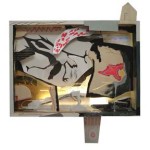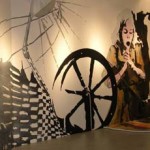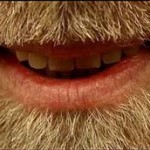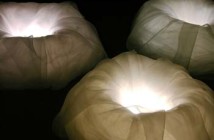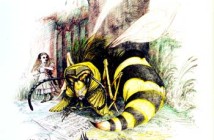Space Other’s raison d’être is to provide a venue for artists who would not otherwise have the opportunity to show in Boston, or even outside of their native countries. The current show, “Closer,” features the work of seven contemporary German artists and is curated by Kerstin Niemann, who is also German. The show’s title refers to the title of Joy Division’s final album, which was released in 1980, a few months after lead singer Ian Curtis hung himself. This reference is intended to call to mind the experimental nature of that album, and to suggest the possibilities inherent in experimentation. While I had a difficult time making this connection—revisiting Joy Division’s music didn’t help—I found the show challenging and engaging.
The viewer is meant to engage with the work in “Closer” in an attempt “to gain an insight into the complexity of social space and its conditions.”* Thus, Norbert Schwontkowski’s muted paintings depict the exteriors of public buildings (one is titled “Suburb Church”) without actually showing the people who might occupy them. Gabriela Jolowicz’s crude woodcuts seem almost mediaeval on first glance. Upon closer inspection, they are revealed to be scenes of contemporary German life with titles life “Spätkauf Bornaische Str. (supermarket Bornaische Street),“ rendered in such a way as to make them seem almost timeless. Kora Jünger’s series of eloquent line drawings, “Youme and Meyou,” show individuals being physically restrained by policemen or soldiers. Inspired by media images, Jünger’s figures are rendered faceless, stripped of their identity beyond the dichotomy of restrained/restrainer, yet it remains unclear if those being restrained are perpetrators—or victims.
At once mesmerizing and repulsive, Herlinde Koelbl’s “Goldmund” (gold mouth) offers a literal interpretation of the word closer. Koelbl’s video piece projects close-ups of the mouths of people she interviewed about money (i.e. what they would do if they had lots of it). Two flanking screens offer extreme close-ups of individual mouths, while a central screen features a collage of mouths and German voices, increasing one’s sense of dislocation. This sense of displacement is presumably lessened if one is fluent in German. Several answers translated into English and posted in the gallery produce the simultaneous effect of dissatisfaction, fantasy and restlessness: they reveal the desire of those interviewed to stop working, to, variously, burrow into the earth to make a home or travel around the globe, while one respondent tentatively suggests that it might be possible to buy time.
In his “Duplex Crime Series,”Juergen Staack manipulates surveillance camera footage, seamlessly juxtaposing robbers so that they face one another rather than their victims, turning what could be threatening images into humorous ones. This exhibition coincides with his “left behind / missing-pictures” project, debuting now (somewhere) in Boston (www.missing-pictures.net). The project involves installing original works of art in the form of Polaroids in a public space; Staack then places missing ads in local newspapers. Thus, the photograph—rather than the person captured in it—becomes the sought-after object.
Moving away from depictions of people and (familiar) places, Tjorg Douglas Beer’s playful mixed media constructions evoke urban wastelands devoid of life. “Keinbrain” resembles a patchwork quilt assembled from brightly colored paper and tape; the prominent placement of an atom bomb suggests the aftermath of a nuclear attack. Jörn Stahlschmidt’s multi-plane drawing, “The Wyren, The Will and The Waever,” is intended as an urban fairytale, and one with ominous overtones at that. The painting was created specifically for “Closer,” and activates the space in a way that the other works do not. The same is true of his “Drag Piece,” a cocoon-like installation made of fabric that is actually meant to be draped over the heads of three people. Indeed, I found myself wanting to crawl inside it.
The work in “Closer” isn’t as experimental as its title would imply, but it is congruent with contemporary work being shown in cities like New York and London. As Michel Foucault wrote in “Des Espaces Autres”—after which Space Other takes its name—“our experience of the world is […] that of a network that connects points and intersects with its own skein.”
----
* from the Space Other Newsletter
Links:
Space Other
"Closer" is on until December 31st at Space Other, located at 63 Wareham St. in the South End (Boston).
All images are courtesy of the artists and Space Other.


